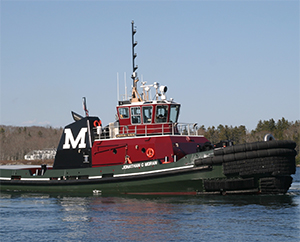McAllister planning for the future with Tier 4 tugs
McAllister Towing has embarked on an aggressive building plan over the past decade, adding powerful tractor tugs at its ports along the Eastern Seaboard. Now, the company is preparing for the next generation of escort and docking boats.
McAllister, based in New York, is building two Tier 4 z-drive tractor tugs at Horizon Shipbuilding of Bayou La Batre, Ala. The diesel-powered vessels designed by Jensen Maritime Consultants of Seattle are due in April and July 2017. They’re expected to be among the first Tier 4 escort tugboats in service in the U.S.
The first of the new tugs is named for Capt. Brian A. McAllister, the company chairman, while the second has been named for his wife, Rosemary McAllister. One vessel will work in New York City and the other likely will be assigned to Norfolk, Va.
Upon arrival, the two tugboats will become the most powerful in McAllister’s roughly 75-vessel fleet. The 100-by-40-foot tugs will have 6,770 hp supplied by two Caterpillar 3516E engines with Schottel SRP 4000 FP z-drives, producing 80 metric tons of bollard pull. Both will be outfitted with Markey winches on the bow and stern, and Cat gensets and fire pumps.
Jensen and McAllister designed these tugs to handle the massive “new Panamax” ships expected once the Panama Canal expansion is complete. This new tugboat class is slightly larger than McAllister’s existing fleet of tractor tugs, most of which are 96 feet long and 36 feet wide.
“This here is larger than the standard (McAllister tug), but it is also for offshore escorting,” said Martin Costa, McAllister’s engineering manager. “To be able to meet the ships offshore, we wanted to go with a larger platform for better sea-keeping ability.”
Costa expects the new variant of Cat’s proven 3516 engine line will perform just as well as its Tier 3 siblings. Cat’s Tier 4 engines use selective catalytic reduction, or SCR, to meet the Tier 4 emissions standards. This system requires additional engine room equipment, including piping, a dosing tank and urea to capture pollutants. This fluid must be changed at set intervals.
Despite higher build costs and maintenance expenses from the Tier 4 system, Costa expects the new engines will be noticeably more efficient. Projected fuel savings, even at current prices, are enough to offset the cost of the urea treatment.
“One of the ways to meet Tier 3 was engine timing, and it made engines less efficient,” he said. “With Tier 4 and SCR able to clean emissions, we were able to put the timing back to a more fuel-efficient setting. We’re not only reducing emissions but reducing fuel burn.”
Once finished, the Tier 4 vessels will be the 32nd and 33rd tractor tugs in McAllister’s fleet.
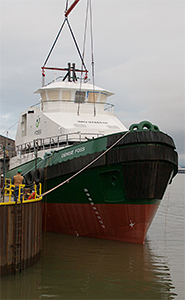 |
|
Denise Foss is the second 123-foot Arctic-class tug Foss has built at its Rainier, Ore., yard. |
|
Courtesy Foss Maritime |
Jonathan C Moran
Since 2011, Washburn & Doughty of East Boothbay, Maine, has delivered nine 93-foot z-drive tugboats for Moran Towing. At press time, the shipyard was putting the finishing touches on the 10th, the powerful Jonathan C Moran.
The 93-by-38-foot tug designed by Washburn & Doughty was expected in May. It will perform ship docking and escort work, although Moran has not yet chosen a port for the new tug.
Jonathan C shares many of the same characteristics as its siblings, including two EMD 12-710 Tier 3 engines producing 6,000 total horsepower, with Schottel SRP 1515 FP z-drives. Electrical power comes from twin John Deere PowerTech 4050 generators producing 99 kW each.
On deck, the vessel has a Markey DEPC-48 hawser winch and a Markey CEW-60 two-speed electric capstan, with Morse and Viking fendering. The tug will have 75 metric tons of bollard pull.
Jonathan C will become the newest in Moran’s roughly 100-boat fleet, but it won’t hold the title for long: The twin-screw z-drive tugs Jack T. Moran and Cooper Moran are expected later this year.
Denise Foss
During its first summer at work, Foss Maritime’s Arctic-class tug Michele Foss helped haul massive modules from South Korea to the Alaskan oil fields. On the way, the vessel delivered last year maneuvered through meter-thick ice while clearing a new route to the North Slope.
Foss, of Seattle, was expecting the second vessel in the Arctic class in May. Naval architecture firm Glosten, also of Seattle, designed the 123-by-41-foot Denise Foss and Foss built the vessel at its Rainier, Ore., yard. The new tug is virtually identical to Michele and is rated for ocean towing around the world, including the Arctic.
Like its predecessor, Denise has twin Caterpillar C280-8 Tier 2 engines producing 7,268 total horsepower. Auxiliary power comes from two Caterpillar C-9 Tier 2 generators producing 215 kW while a John Deere 4050 Tier 3 generator producing 99 kW provides emergency power. Denise is rated for 110.5 tons of bollard pull.
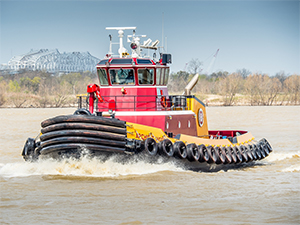 |
|
E.N. Bisso & Son’s new tractor tug Archie T. Higgins working on the Mississippi River near New Orleans. |
|
Brian Gauvin |
The tug has 126-inch, three-blade propellers surrounded by Nautican nozzles with pre-swirl stators. The stern deck has a Markey double-drum TDSD-40 towing winch, and there is a Markey WEWD-22 winch on the bow. Firefighting equipment includes a Flowserve 10-hp water pump.
“The Michele was designed with safety, efficiency and the environment in mind,” said Gary Faber, Foss’ senior vice president for marine transportation. “Working with Glosten, Foss was able to create a tug that not only meets performance, operational and maintenance needs, but is a state-of-the art vessel that raises the bar for technical capability and safety.
“Now in her second season, the Michele has proven herself in the Arctic, and serves as the flagship to Foss,” he continued.
The third vessel in the class, Nicole Foss, is under construction at Foss’ Rainier yard and is scheduled for delivery in summer 2017.
Jeffrey McAllister
The pending arrival of McAllister’s new Tier 4 tugs signals the end of McAllister’s proven class of 96-foot Tier 3 tractor tugs. The last of the series, Jeffrey McAllister, is under construction at Eastern Shipbuilding in Panama City, Fla. The 96-by-34-foot vessel is scheduled for delivery in November.
“Currently, she is bound for our Charleston, S.C., operations,” said McAllister spokesman Craig Rising. “The inclusion of the Jeffrey would make that port all tractor tugs for us.”
Jeffrey is named for fifth-generation family member and senior docking pilot in New York, Capt. Jeffrey McAllister.
Propulsion comes from two EMD 8-710 G7B Tier 3 main engines producing 5,000 hp, with Schottel SRP 1215 FP z-drives. Backup power comes from two John Deere 4045AFM85 generator units. The tug is rated for 66.5 tons of bollard pull.
Jeffrey McAllister will have a JonRie Series 250 escort winch on the bow and a JonRie Series 230 line winch on the stern. It can carry up to 450 feet of 2.25-inch Samson Proton-8 line.
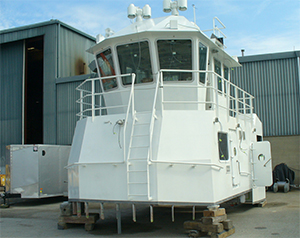 |
|
The single-screw tug Iron Guppy goes to work in Toronto Harbor starting in summer 2016. |
|
Photo courtesy Hike Metal Products |
Firefighting equipment consists of a John Deere 6090AFM75 rated at 3,000 gallons per minute and two FFS monitors with foam injection capability.
Iron Guppy
The single-screw icebreaking tugboat William Rest has operated from the Port of Toronto since the early 1960s, but its long tenure is coming to an end. Iron Guppy, a single-screw tug, will replace the venerable vessel in summer 2016.
Robert Allan Ltd. of Vancouver, B.C., designed the new 65-by-21-foot vessel for PortsToronto, and it is under construction at Hike Metal Products of Wheatley, Ontario.
Students at a Toronto elementary school named the new vessel, which has a similar size, engine power and single-pitch prop as the 55-year-old William Rest. Iron Guppy has a 750-hp Cummins QSK19-M engine driving through a ZF W3355 4:1 gearbox. The vessel’s bow is capable of breaking up to 6 inches of ice. It will be rated for 6 tons of bollard pull and can accommodate a six-person crew.
“The port was quite happy with the operational characteristics of the (existing) vessel, so in a way it’s a bit of a legacy design,” said Rollie Webb, senior vice president with Robert Allan, who noted that the new tug features modern amenities and equipment throughout.
After delivery, the vessel will perform dredge and icebreaking work in Toronto Harbor, according to PortsToronto. It also will assist Toronto police and fire service marine units when needed.
Archie T. Higgins
E.N. Bisso & Son of New Orleans took delivery in December of the z-drive reverse tractor tug Archie T. Higgins, which works escorting ships on the Mississippi River.
The tug, at 96 feet by 34 feet with a draft of 14.75 feet, is named for a longtime former employee and board member at the New Orleans company. Archie is the fourth vessel in a series built at Eastern Ship-building in Panama City, Fla., and designed by Jensen Maritime Consultants of Seattle. Josephine Anne, Beverly B and Elizabeth B are the other tugs in the series.
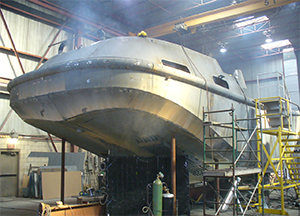 |
|
Iron Guppy’s hull under construction at Hike Metal Products. |
|
Photo courtesy Hike Metal Products |
“Eastern built a perfect boat for us for ship docking,” said William McDonald, president of E.N. Bisso & Son.
Archie has two Caterpillar 3516C Tier 3 engines rated for 4,260 total hp with two Rolls-Royce US 205-P18 z-drives. Electrical power comes from two John Deere 4045AFM85 Tier 3 gensets, each rated at 99 kW.
For firefighting equipment, the vessel has a Caterpillar C18 with a Nijhuis 5,248-gpm pump and InMar/FFS dual-flow monitor. On deck is a Markey DEPCF-42 single drum 40-hp electric escort hawser winch.
Janet D.
Construction & Marine Equipment Co. of Elizabeth, N.J., has taken delivery of a 68-foot model bow tugboat. Janet D., built and designed by Rodriguez Shipbuilding of Coden, Ala., was delivered in November.
The 1,400-hp tug was designed to tend and shift construction barges in and around New York Harbor.
“It’s been busy,” Paul Dengel, who heads operations for the construction firm, said of Janet D. “It’s been on charter since the first of the year.”
The tug, named for company co-owner Janet Dengel, is powered by two Cummins QSK19 Tier 3 engines. Those mains turn twin 66-inch, four-blade open-wheel propellers. The vessel also has two John Deere 45-kW generators supplying electrical power. On deck, it has two 240-ton Wintech International winches.
The vessel replaces Maria J., the lone tugboat in the firm’s fleet.

